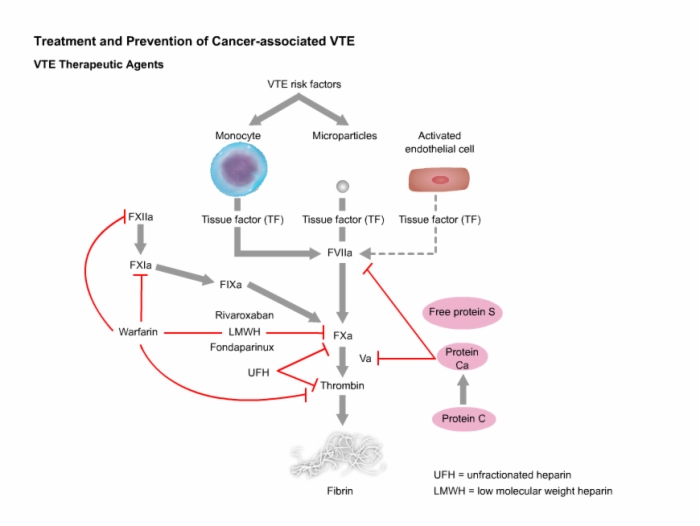SMi Source lesson Cardiovascular: Cancer VTE has the following microlearning topics
1. Venous Thromboembolism (VTE) Overview


2. VTE and Cancer


3. Incidence of Cancer in VTE Patients


4. Knowledge Check: Risk of Cancer in Patients with VTE


5. Knowledge Check: Piccioli et al. (2004) Trial


6. Incidence of VTE in Cancer Patients


7. Risk Factors for Cancer-associated VTE


8. Cancer-related Risk Factors


9. Assessing Impact of Treatment on VTE Risk From Observational vs. Randomized Controlled Studies


10. Knowledge Check: Incidence of Cancer-Associated VTE


11. Knowledge Check: Newly Diagnosed Cancer Patients


12. Mechanisms Underlying Cancer-associated VTE


13. Knowledge Check: NETs


14. Knowledge Check: Inflammatory Cytokines Promoting Thrombosis


15. Risk Assessment Tools


16. Diagnosis of Cancer-associated VTE: Wells Score


17. Prognosis and Risk Factors of Cancer-associated VTE


18. Knowledge Check: Khorana Risk Tool


19. Knowledge Check: Poor Prognosis


20. VTE Therapeutic Agents


21. Surgery Patients


22. Outpatients receiving chemotherapy: Agnelli et al, 2009


23. Outpatients receiving chemotherapy: Preventive Therapy Trials


24. Prevention of VTE Recurrence


25. Anticoagulant Treatment and Survival


26. Guidelines for VTE Prevention and Treatment


27. Knowledge Check: ASCO 2013 Guidelines


28. Knowledge Check: Secondary Prophylaxis


29. Summary: Cancer-associated VTE


Lesson Cardiovascular: Cancer VTE teaches these concepts
Overview: Cancer VTE, Venous Thromboembolism (VTE) Overview
Lesson Cardiovascular: Cancer VTE addresses these key points
Venous Thromboembolism (VTE)
- Deep vein thrombosis (DVT) and pulmonary embolism (PE)
- Prevalence- 1-3 per 1,000
- Incidence- 1.43 per 1,000 person-years
- DVT at 0.93 per 1,000 person-years
- PE at 0.5 per 1,000 person-years
- 30-day mortality rate after VTE >25%
- 10-year recurrence rate ~30%
VTE Risk Factors
Acquired:
- Recent surgery
- Trauma
- Prolonged immobility
- Venous catheters
- Pregnancy
- Cancer
- Obesity
Genetic:
- Anticoagulant deficiencies
- Factor V Leiden
- Prothrombin G20210A
- Fibrinogen C10034T
- Non-type O blood group
- Oral contraceptive use
- Factor V Leiden mutation
- Oral contraceptive use AND factor V Leiden mutation
Virchow’s Triad
Three physiological changes contribute to thrombosis:
- Blood flow
- Blood vessel integrity
- The blood itself
Reduced blood flow or stasis can be caused by:
- Surgery
- Periods of reduced mobility
- Long distance travel
The circulation of microparticles acts as a primary trigger for the activation of the coagulation cascade.
The expression of tissue factor is increased by VTE risk factors, including:
- Surgery
- Trauma
- Obesity
- Cancer
Lesson Cardiovascular: Cancer VTE is built from these main references. Log into SMi Source for a complete list and details.
Heit, J. A., Mohr, D. N., Silverstein, M. D., Petterson, T. M., O'Fallon, W. M., & Melton, L. J. (2000). Predictors of recurrence after deep vein thrombosis and pulmonary embolism: a population-based cohort study. Archives of Internal Medicine, 160(6), 761-768.
Manly, D. A., Boles, J., & Mackman, N. (2011). Role of tissue factor in venous thrombosis. Annual review of physiology, 73, 515.
Mohr, D. N., Silverstein, M. D., Heit, J. A., Petterson, T. M., O'Fallon, W. M., & Melton III, L. J. (2000, December). The venous stasis syndrome after deep venous thrombosis or pulmonary embolism: a population-based study. In Mayo Clinic Proceedings (Vol. 75, No. 12, pp. 1249-1256). Elsevier.
Naess, I. A., Christiansen, S. C., Romundstad, P., Cannegieter, S. C., Rosendaal, F. R., & Hammerstrøm, J. (2007). Incidence and mortality of venous thrombosis: a population‐based study. Journal of Thrombosis and Haemostasis, 5(4), 692-699.
Vandenbroucke, J. P., Rosing, J., Bloemenkamp, K. W., Middeldorp, S., Helmerhorst, F. M., Bouma, B. N., & Rosendaal, F. R. (2001). Oral contraceptives and the risk of venous thrombosis. New England Journal of Medicine, 344(20), 1527-1535.